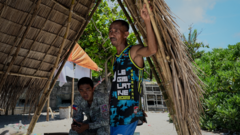As Chinese ships loom near Pagasa Island, the small Filipino community strives to maintain their way of life and assert territorial claims. With a military and civilian presence, they navigate challenges posed by territorial disputes and seek support from their government while adapting to the harsh realities of life in a contested region.
Pagasa Island: A Small Community's Stand Against Chinese Expansion

Pagasa Island: A Small Community's Stand Against Chinese Expansion
Amidst rising tensions in the South China Sea, the Philippines-controlled Pagasa Island embodies hope and resilience against encroaching Chinese maritime claims.
The island of Pagasa, aptly named "Hope," stands as a symbol of resistance against China's maritime expansion in the South China Sea. At just 37 hectares, it supports a small population of around 300 residents who live in modest wooden houses, engage in fishing, and cultivate limited crops in a sandy landscape. However, their tranquility is threatened by the persistent presence of Chinese naval vessels, as the island's strategic location places it under dispute.
Nestled in this contested sea, Pagasa is not only significant for its physical presence but also for its civilian inhabitants, a rarity among the islands claimed in the area. According to Jonathan Malaya, the assistant director-general of the Philippines National Security Council, Pagasa's status as solid land bolsters the Philippines' legal claims. It has historically been under Philippine control since being annexed from Taiwan in 1978, and its airport expansion allows for essential supplies and military support to reach the community.
Supplies are regularly flown in, often carried by large military transport airplanes packed with food, water, and materials essential for survival. Remarkably, recent developments have bolstered the island's infrastructure, with a newly built hangar and dredged harbor aiding accessibility. However, fishermen like Larry Hugo face intimidation and harassment from the larger Chinese ships that threaten their livelihoods by limiting their fishing grounds.
Despite ongoing challenges, residents find solace in their close-knit community, enjoying basic needs through government support while experiencing a unique, peaceful lifestyle far from urban pressures. Teachers like Realyn Limbo emphasize the importance of education, witnessing growth in their schools despite rural limitations. Healthcare worker Melania Alojado notes their struggles dealing with health emergencies, highlighting the limitations posed by geographical isolation.
As political tensions continue to shape the region, the Philippines government is taking a more assertive stance compared to previous leaderships, lodging formal protests against Chinese vessels. Amidst the backdrop of geopolitical struggles, Pagasa Island exemplifies the delicate balance of resistance, survival, and community identity in the face of increasing external pressures.





















